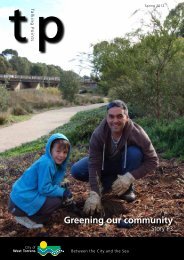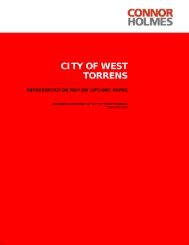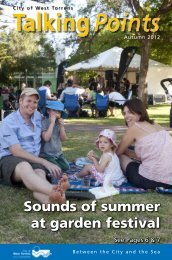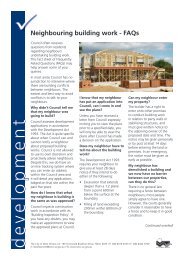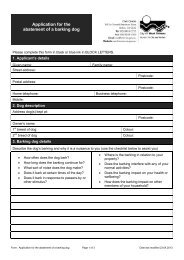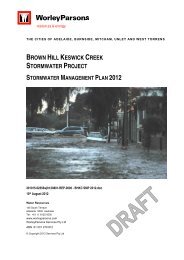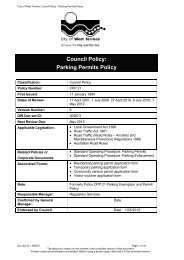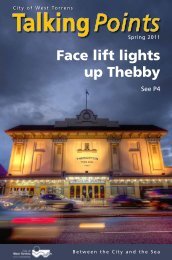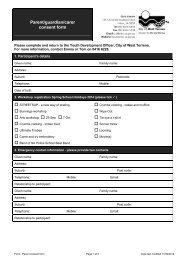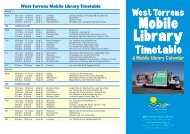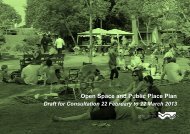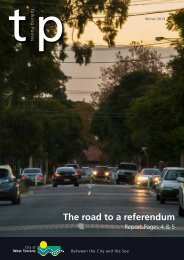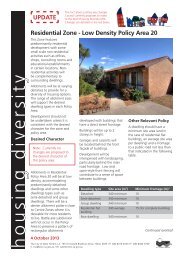Recommendations - City of West Torrens - SA.Gov.au
Recommendations - City of West Torrens - SA.Gov.au
Recommendations - City of West Torrens - SA.Gov.au
Create successful ePaper yourself
Turn your PDF publications into a flip-book with our unique Google optimized e-Paper software.
12.0<br />
Local Road Network<br />
Movement function predominate<br />
for such roads, with clearways<br />
sometimes provided to satisfy capacity<br />
requirements.<br />
In recent years, functional classification<br />
<strong>of</strong> roads have been used. For example,<br />
DTEI’s functional classification<br />
describes the predominant use <strong>of</strong> a<br />
particular road:<br />
• strategic routes (all modes)<br />
• freight routes<br />
• car (commuter) access routes<br />
• tourist routes<br />
• passenger transport routes<br />
• pedestrian zones<br />
• cycling routes<br />
The issue <strong>of</strong> road classification was<br />
considered in the Metropolitan Local<br />
<strong>Gov</strong>ernment Transport Strategy.<br />
The Strategy notes that it would<br />
be desirable to have a uniform system<br />
in the metropolitan area and this<br />
is supported.<br />
Without being overly prescriptive,<br />
it is desirable to have a uniform<br />
system for classifying roads throughout<br />
the metropolitan region.<br />
Accordingly, the following threetiered<br />
classification model is <strong>of</strong>fered<br />
for consideration:<br />
• road hierarchy (i.e. to determine<br />
road responsibility)<br />
• road functionality (i.e. to identify<br />
how a road should operate)<br />
• road land use relationship.<br />
The value <strong>of</strong> this approach is that the<br />
transport and access/land use role <strong>of</strong><br />
each road can be better described,<br />
which can lead to development <strong>of</strong><br />
clearer road performance criteria.<br />
The interrelationship between the<br />
road environment and adjacent land<br />
uses can also be better understood,<br />
along with the compromises that<br />
are <strong>of</strong>ten needed in managing the<br />
available road space.<br />
MLGTS study August 2005<br />
The <strong>SA</strong> Grants Commission has also<br />
used the functionality <strong>of</strong> a road (a<br />
three-tier classification <strong>of</strong> freight,<br />
tourism and social) as part <strong>of</strong> its Special<br />
Local Roads funding considerations.<br />
The MLGTS has proposed the following<br />
functional hierarchy description:<br />
Freight route - Facilitates industry<br />
development by linking key industries<br />
to major transport routes and<br />
contributes to efficient movement <strong>of</strong><br />
large volumes <strong>of</strong> heavy freight vehicles.<br />
Primary Freight Routes link strategically<br />
important economic regions within and<br />
external to the State. Secondary Freight<br />
Routes link urban and regional freight<br />
generators and providing connections<br />
to primary freight routes –<br />
See Figure 10.<br />
Social access routes - Provides for<br />
community development and equitable<br />
access to community facilities whilst<br />
minimising the impact <strong>of</strong> heavy<br />
vehicles on the community. Routes that<br />
provide a high level <strong>of</strong> connectivity<br />
between areas (through routes),<br />
including those that supplement the<br />
arterial road network, or that provide<br />
immediate access to community spaces<br />
or recognised shopping precincts.<br />
See Figure 11.<br />
Tourist routes - provides access to<br />
tourism sites and locations and enables<br />
people to view scenic attractions in<br />
a safe and enjoyable manner. Tourist<br />
routes can be described as either being<br />
part <strong>of</strong> the attraction (i.e. destination)<br />
or part <strong>of</strong> the route to/from the<br />
destination or attraction.<br />
See Figure 12.<br />
Passenger public transport routes<br />
• routes that support the use <strong>of</strong><br />
passenger transport including<br />
strategic bus routes as well as routes<br />
that provide access to associated<br />
facilities (e.g. park-n-ride areas) –<br />
See FIGURE 8 in Section 9.0.<br />
Bicycle routes - key cycling routes –<br />
see bicycle routes in Strategic Bicycle<br />
Plan report<br />
Pedestrian routes - key pedestrian<br />
routes – to be prepared under Pedestrian<br />
Footpath Plan (See Section 8.0).<br />
The functional road hierarchy is shown<br />
in FIGURES 10 to 12.<br />
Recommendation<br />
• Adopt the proposed classical and<br />
functional road hierarchy classification<br />
<strong>of</strong> roads as shown in Figures 9 to 12.<br />
12.2 Local Network Issues<br />
A number <strong>of</strong> improvements have<br />
previously been identified for some <strong>of</strong><br />
the “collector roads”. For example, in<br />
a recent detailed traffic investigation<br />
for the Garden Terrace area in<br />
Underdale, upgrades to the Holbrooks<br />
Road junction and Garden Terrace/<br />
White Avenue junction were identified<br />
for future implementation.<br />
Table 3 provides a list <strong>of</strong> local<br />
intersections with arterial roads that<br />
have been considered in past traffic<br />
reviews or are know “problem” sites.<br />
Part 1 - Overview | Local Road Network 57



